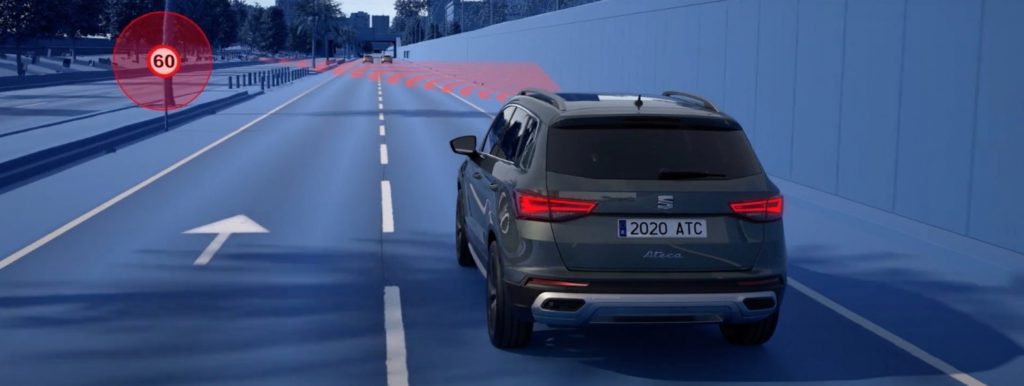SEAT’s speed detection system could drive down fines
29 March 2021

SEAT has drawn back the curtain on its Dynamic Road Sign Display (DRSD), an automatic speed adjustment system. Utilising a front-mounted camera that can detect speed signs, vehicles can adjust to local limits by themselves.
As well as increasing road safety, the carmaker predicts the system could prevent drivers paying out a considerable amount of money in potential speeding fines. According to new research from SEAT, DRSD could save drivers in the UK some £327 million (€383 million).
Second pair of eyes
Speaking with Autovista Group’s Daily Brief, a SEAT spokesperson explained how DRSD works. A camera mounted at the top of the windscreen scans the road ahead for traffic signs. A signal is then sent to anonboard computer, alerting the driver while slowing the vehicle down through adaptive cruise control.
It is also possible for DRSD to increase the vehicle’s speed; however, it will not exceed the originally set limit. For example, if the car were set to 60mph (96km/h), it would not accelerate up to 70mph unless the driver overrode the system by putting their foot down. The technology is also capable of scanning school zones and other road markers.
While it is not yet able to distinguish out-of-use signs, as this constitutes the next level of computer learning, this does provide an opening for future technological development. DRSD will be available in SEAT models across Europe and the UK. As part of the Volkswagen (VW) Group, it will also make appearances in other brands, such as VW passenger cars and Skoda.
A fine way to save
SEAT points out DRSD contains the potential to save motorists money on speeding fines. Conducting a study of 2,000 UK motorists, the carmaker found nearly 10% admitted to being caught speeding annually. It calculated that with a £100 speeding ticket, 10% of the 32.7 million licensed drivers were paying £327 million in fines.
Statistics published by the UK Department for Transport (DfT) show that over 50% of cars exceeded the speed limit on 30mph roads; while 47% broke the limit on motorways, between October and December last year. Furthermore, even with the decrease in traffic due to COVID-19 restrictions, this proportion of cars was similar to 2019.
SEAT’s study revealed that 76% of drivers don’t always know what speed they are travelling at. This is where a system like DRSD could be immensely useful, particularly where changeable speed limits are involved. There appears to be consumer interest too, with the OEM’s study finding that roughly 40% of drivers would want a similar technology to DRSD in their car if it was available.
′It is certainly eye-opening to see that significant numbers of motorists are not necessarily always aware of their own speeds, but thankfully there is in-car technology – like our Dynamic Road Sign Display – already on the market to make drivers safer on the road,’ said Richard Harrison, managing director of SEAT UK.
As lockdown eases in the UK, the number of people returning to the roads will increase. A deficit in recent experience could mean less confident drivers and a potentially higher number of mistakes or even brash confidence. A system capable of recognising changing speed limits could save these consumers from a fine and points on their licence. It could also help to prevent serious accidents and injuries caused by speeding. As the technology develops and becomes capable of discerning relevant information, it will only become more desirable.